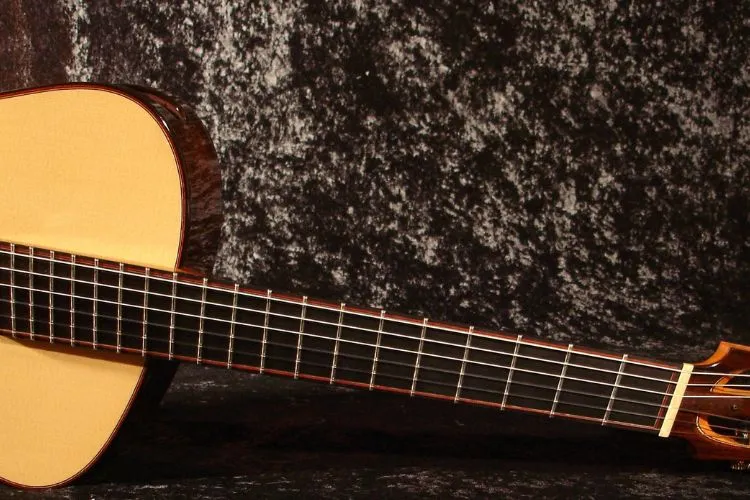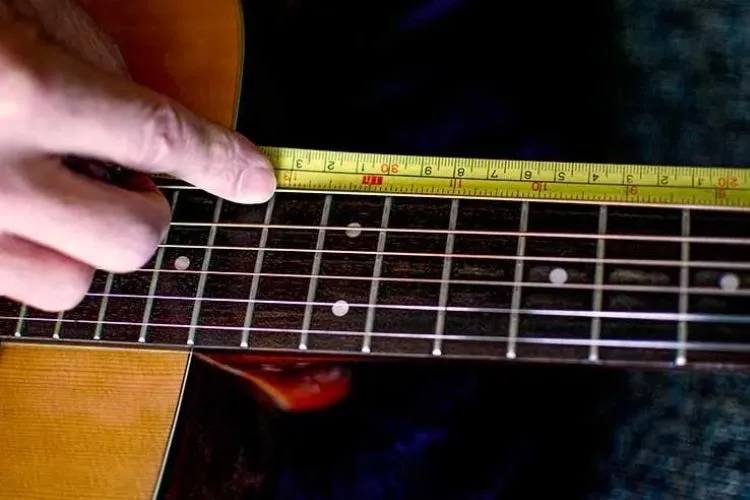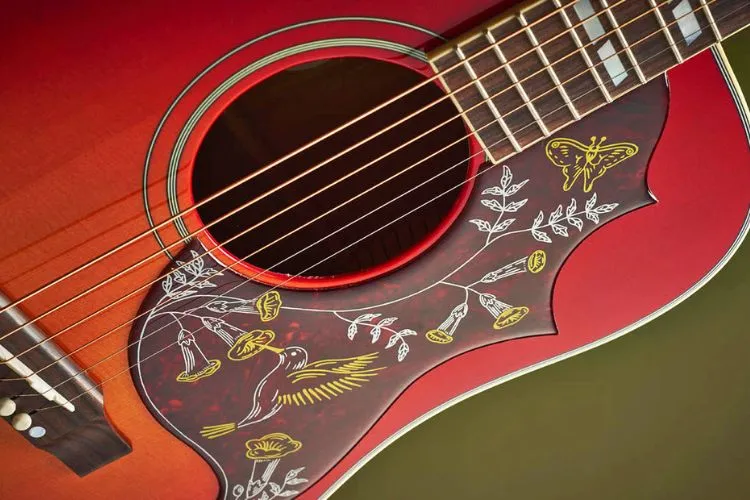The acoustic guitar, with its rich harmonies and intricate melodies, has enchanted musicians and audiences alike for centuries. Integral to its design and sound are the frets, those small metal strips across the neck that help define the notes played.
But how many frets are on an acoustic guitar, and what does this number mean for the musician? This article delves deep into the world of acoustic guitars, unraveling the mystery of frets and their impact on music.

Contents
- 1 🎶Understanding Guitar Frets
- 2 🎶How Many Frets Are On An Acoustic Guitar? Standard Fret Numbers
- 3 🎶Factors Influencing the Number of Frets
- 4 🎶Exploring 20-Fret Acoustic Guitars
- 5 🎶Beyond the Standard: Less Common Fret Counts
- 6 🎶Choosing the Right Fret Number for Your Playing Style
- 7 🎶Pro Tips: Maximizing Your Guitar’s Potential
- 8 🎶frequently asked question (FAQs)
🎶Understanding Guitar Frets
Frets are vital to a guitar’s functionality. They are placed along the neck of the guitar, dividing the scale into fixed intervals. When a string is pressed down against the fretboard just behind a fret, it shortens the vibrating length of the string, raising the pitch of the note it produces.
This mechanical action is what allows guitarists to execute chords and melodies with precision. The positioning of these frets is a science in itself, requiring mathematical exactitude to ensure each note plays in tune.
🎶How Many Frets Are On An Acoustic Guitar? Standard Fret Numbers
Typically, acoustic guitars come with a range of 18 to 24 frets, but the most common configurations are those with either 20 or 21 frets. There are variations, mainly influenced by the guitar’s design and the music it is intended to play.

How Many Frets Are On An Acoustic Guitar? 12 Fret vs. 14 Fret Guitars
A significant differentiation in acoustic guitars is the distinction between 12-fret and 14-fret necks. Traditionally, guitars were constructed with the body joining the neck at the 12th fret.
This design is still prevalent in classical guitars and some steel-string acoustics, particularly those designed for fingerstyle playing. The longer body and neck interaction provide a distinct tonal quality, often described as warmer.
Conversely, modern acoustic guitars frequently feature necks that join the body at the 14th fret. This design offers easier access to the upper registers of the fretboard, beneficial for soloing and playing higher-pitched melodies. It reflects a shift in playing styles and the evolution of music genres over the years.
Special Cases and Variations
While 20 and 21-fret designs dominate, there are exceptional models tailored to specific needs. Some guitars feature extended fretboards that reach up to 24 frets, accommodating genres that demand a wide range of notes, such as solo acoustic jazz and progressive rock.
🎶Factors Influencing the Number of Frets
Several factors dictate the number of frets on an acoustic guitar, including body style, scale length, and manufacturer design choices. Larger body guitars might offer more space for additional frets, but ergonomic considerations and the desired sound also play crucial roles.
The scale length, or the string length between the nut and the bridge, influences fret spacing and count. Manufacturers, meanwhile, align their design choices with the playing styles and preferences of their target market, balancing tradition with innovation.
🎶Exploring 20-Fret Acoustic Guitars
The 20-fret acoustic guitar stands as the industry standard, striking a balance between range and playability. This configuration offers a full octave above the guitar’s open strings, accommodating most traditional and contemporary music genres.

The choice reflects a consensus among manufacturers about the optimal layout for a versatile, expressive instrument that serves a broad spectrum of players.
🎶Beyond the Standard: Less Common Fret Counts
Guitars with fewer than 20 frets or more than 21 illustrate the diversity within the world of acoustic instruments. Fewer frets might signify a design focused on chordal play and rhythm, common in folk and classic country music, where the guitar primarily serves as a rhythm instrument.
On the other hand, guitars with more than 21 frets cater to lead guitarists seeking extensive solo capabilities and a wider note range.
🎶Choosing the Right Fret Number for Your Playing Style
The appropriate number of frets for a guitarist hinges on their playing style and the music genres they prefer. Fingerstyle players might lean towards a 12-fret design for its tonal qualities, while soloists could favor guitars with more than 20 frets for their expansive range.

It’s essential for musicians to consider how the fret number aligns with their musical needs, playing techniques, and desired sound.
🎶Pro Tips: Maximizing Your Guitar’s Potential
Adapting to different fret counts comes with practice and experimentation. Guitarists should familiarize themselves with the layout of their instrument, exploring the unique tonal qualities each fret position offers.
For those transitioning between guitars with varying fret numbers, it’s crucial to adjust finger positioning and chord shapes to maintain intonation and playability.
Leveraging frets creatively can enhance music composition and performance. Innovative techniques such as harmonics, fret tapping, and sliding can unlock new sonic possibilities, making the number of frets a gateway to creative expression rather than a limitation.
Other basic information: How Big Is a Full Size Guitar? | How to Level Guitar Frets
🎶frequently asked question (FAQs)
The variation in fret numbers among acoustic guitars is primarily due to differences in playing styles, music genres, and manufacturer design innovations. More frets allow for a greater pitch range, catering to soloists and genres requiring extensive melodic play.
Modifying an acoustic guitar to add more frets is technically possible but complex and often not cost-effective. It would require significant alterations to the neck and fretboard, which could compromise the instrument’s integrity and sound. It’s usually more practical to select a guitar with the desired number of frets from the outset.
The number of frets doesn’t directly affect guitar tuning, which is determined by the pitches of the open strings. However, more frets provide access to a higher register, extending the range of notes the guitar can produce in tune. The design and construction of the fretboard ensure that each fret accurately divides the scale length, maintaining intonation across the fretboard.
Conclusion:
The number of frets on an acoustic guitar varies, reflecting diverse musical styles, playing techniques, and sonic preferences. From the traditional 12-fret layout to the standard 20-fret design and beyond, each configuration offers unique possibilities for expression and creativity.
Understanding the impact of fret count on playability and tone is essential for every guitarist, guiding their journey through the rich landscape of acoustic music.
